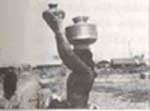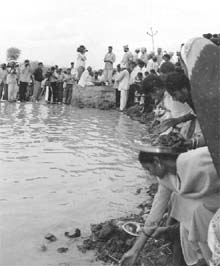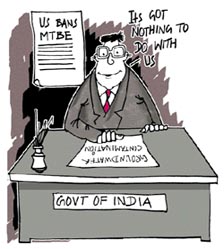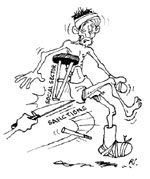
Standing up for water
At long last, someone has spoken out for rural women. The Standing Committee on Urban and Rural Development wants the government to change existing norms and provide safe drinking water in rural

At long last, someone has spoken out for rural women. The Standing Committee on Urban and Rural Development wants the government to change existing norms and provide safe drinking water in rural

<b>Report card:</b> The government realised its failures and learned from the civil society. Despite cases of corruption and some errors in planning, the government programme is an achievement<br> <b>Success level:</b> Good
Delhi has been experiencing phenomenal growth of population since 1951 recording decennial growth rate of 52.44%, 52.91%, 52.98%, 51.45% and 47.03% during 1951-61, 1961-71, 1971-81 and 1991-01 decades respectively. One of the main causes for this spurt in the growth of population is migration into the city not only from the adjacent states but also from others such as Bihar.
Among steps undertaken by the municipally owned Stockholm Water were renovation of the waste water network, construction of a storm sewer overflow basin and measures to reduce the load on pipes and treatment plants.

Owners of brick kilns resent pollution control measures of the authorities
The municipal authorities of Xi'an, capital of Northwest China's Shaanxi Province, have given top priority to upgrading the urban infrastructure and protecting the surrounding environment during
I see two objectives for urban planning in India: one, environmental sustainability and two, public participation in this planning

There is increasing likelihood that by the early 21st century, water and not energy will claim the primary focus of world attention. There are substitutes for energy other than depleting fossil fuels

The way to clean up the air is to pollute groundwater, according to the Indian government

What was the social yield of the nuclear tests conducted by India? As the sensitive electronic devices measured the output of the blasts, Down To Earth records the reactions of the civil society

Pumping out of the aquifer to supply drinking water is causing Mexico City to sink

Traditionally most urban areas in the country have grown out of rural settlements. Land use changes and population growth have precipitated urbanization in a lot of rural centres. Urbanization also
Thailand is one of the world's leading rainwater harvesting nations. The National Jar Programme was launched to supply clean drinking water to rural areas under the United Nations Water Supply and

The nightmare that ruined kobe stays put in the streets of Japan's prosperous cities, shattering a few economic myths
<p>Nepal has achieved a new milestone in conservation by achieving ‘zero poaching’ of rhinos, tigers and elephants for the year period ending in February 2014, according to the World Wildlife Fund Nepal. Read more in this March 2014 edition of the Monthly Overview on State of Environment, Nepal.</p>
Last fortnight I wrote about the different models of water privatisation. Questions continue to haunt me, but let me try and work towards some resolution. Firstly, there is the issue of pricing of
Every society must understand how the excreta it produces is managed. It teaches us many things about water, about waste, about technologies to clean, economics and politics: of who is subsidised to defecate in our societies. But, most importantly, it teaches us humility. We know so little about our own world.

Jaisalmer fort and the rest of the of the city was built for heat, with wind corridors and the architecture providing built-in comfort for its denizens. Jaisalmer is not unique. Cherrapunji, the
A state government survey says over 76 pc people had to grease the palms of municipal bodies to get basic amenities CHANDIGARH, February 21: It's not a finding the Punjab Government would like to flaunt. A survey sponsored by it has found out that 76.5 per cent of people pay bribes to officials in the various municipal bodies of the state to get their work done. The finding was an outcome of a study conducted by the Institute for Development and Communication (IDC) for the Department of Planning, Punjab Government. The study discovered that 76.5 per cent of the respondents had paid bribe on one occasion and most of them (82.3 per cent) had paid it to one person only. Interestingly, 94.1 per cent of the repondents admitted that the persons concerned had asked for money for redressal of their problems regarding basic amenities such as water, sewerage, streetlights and roads. Besides paying bribes, 37.1 per cent of the people also felt the need to approach an influential person to get their complaints redressed. Interestingly, almost half of the respondents were not in favour of paying bribes for any work at the MC level but were forced to do so. The only exception were people at Jalandhar and Nakodar where 80 per cent and 100 per cent of the respondents, respectively, did not mind greasing palms to get their work done at the municipal corporation. However, in many cases, bribe did not prove to be the ideal solution. Nearly 44.1 per cent of the respondents complained about harassment even after paying the bribe. Only 23.5 per cent felt that their work was done immediately after they paid the bribe, said the study. A large number (37.4 per cent) of respondents felt that middle-level officials were most corrupt, and only 8.1 per cent pointed a finger at the councillors. A majority of the complaints (45.2 per cent) were related to poor water supply followed by faulty streetlights, potholed roads (11.3 per cent) and choked sewerage (8.1 per cent). In Hoshiarpur, poor or polluted water supply accounted for half the complaints, while building construction made up for one-fourth of the grouses. In Moga and Amritsar, blockage of sewerage and poor water supply were the major grouses. In a damning indictment of the municipal bodies, the survey showed that 74.9 per cent of the people were dissatisfied with their grievance redressal system. The Jalandhar municipal body fared most poorly with only 2 per cent of the respondents saying that the civic body was prompt in dealing with grievances. The reasons for corruption, according to the study, ranged from poor work culture, faulty management, lack of proper planning, absence of transparency, to ad hoc allocation of resources. The people surveyed suggested transparency and involvement of the locals in grassroots initiatives would improve the delivery system. Principal Secretary, Local Bodies, DS Bains, however, blamed the old urban infrastructure for the corrupt system. "Urban infrastructure is nearing a collapse in the state for want of investment in the last decade and half. Some unscrupulous elements take advantage of people who want better services. The answer lies in massive investment to upgrade the urban services which we are doing this year.' Show 'em the money Of the 76.5 pc people who bribed Punjab civic body officials to get their work done:

Water will become the most prized and precious commodity in the coming years. Internecine conflicts over the resource are already the order of the day and a global water crisis seems not too far away. But the water-guzzling US state of California is show